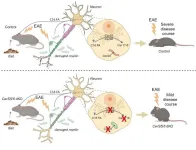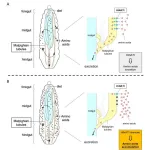Closing in on Parkinson’s Disease proteins in extracellular vesicles in the blood
Precision diagnostics for diseases that affect the brain and other organs brought closer by new ability to exclusively access contents of organ-derived extracellular vesicles in blood
By Benjamin Boettner
(BOSTON) — Brain disorders like Parkinson’s (PD) or Alzheimer’s Disease (AD) start to develop in patients much earlier than when their first clinical symptoms appear. Treating patients at these early stages could slow or even stop their disease, but there is currently no way to diagnose brain disorders at those pre-symptomatic stages. Thus far, the specific brain lesions caused by PD, for example, can only be detected by analyzing brain biopsies, which can only be obtained posthumously.
To overcome this critical bottleneck, researchers have been pursuing the new concept of “liquid biopsies,” which involves the easy extraction of blood or other body fluids using non-invasive procedures, and analyzing them for molecules originating from brain and other solid tissues. A particularly promising target in body fluids are “extracellular vesicles” (EVs), tiny membrane-bound sacs released by brain and other cells into their surrounding fluids. These sacs contain a variety of molecules that can be unique to the cells types that produce them, such as the brain, and thus could also carry protected biomarkers for the early onset of Parkinson’s and other brain diseases.
However, despite recent progress, EV experts haven’t been able to tackle the problem of whether particular biomarker molecules that they measured in isolated EVs are strictly contained inside EVs or non-specifically bound to their surface. This challenge has actually prevented them from being able to make unambiguous conclusions about cargo molecules in EVs from all types of tissues.
Now, a collaborative team led by David Walt, Ph.D. at the Wyss Institute at Harvard University and Brigham and Women’s Hospital (BWH) in Boston has solved this problem by adding a crucial step to an already validated ultra-sensitive protocol. By enzymatically digesting all surface-bound proteins from a purified EV population, they were able to specifically home in on cargo protected inside of EVs while eliminating unspecific “contaminations.” Using their enhanced protocol to measure the PD biomarker ⍺-synuclein in blood, for the first time they were able to accurately determine the small fraction of any protein contained within EVs vs how much of it is present free in total blood plasma.
Importantly, they integrated this advance with a newly developed ultra-sensitive detection assay for a form of ⍺-synuclein that becomes increasingly phosphorylated during the progression of PD and the related condition Lewy Body Dementia. Analyzing a cohort of patient samples, they could detect an enrichment of the pathological ⍺-synuclein protein inside EVs relative to total plasma. The findings are published in PNAS.
“Research on EVs in our and other groups over the last few decades has steadily advanced our understanding of their complex biology and molecular composition. Yet, the isolation of pure tissue-specific EVs from body fluids like blood or the cerebrospinal fluid surrounding the central nervous system, including the brain, and validating and quantifying their true contents with precise measurements still present formidable technical challenges,” said Wyss Core Faculty member Walt. “Our recent work is providing a solution to help fill this technological gap, and gets us closer to being able to obtain EVs free from contamination in order to use them as rich sources for clinical biomarkers, as we show with the example of phosphorylated ⍺-synuclein.” Walt, who is the faculty lead of the Wyss Institute’s Diagnostic Accelerator, is also the Hansjörg Wyss Professor of Biologically Inspired Engineering at Harvard Medical School (HMS), Professor of Pathology at Brigham and Women’s Hospital, and a Howard Hughes Medical Institute Professor.
From blood to EVs to biomarkers to diagnosis
Especially motivated by the diagnostic promise of EVs for the early diagnosis of PD, AD, and other brain disorders, the Walt group has been systematically filling vital pieces into this technical jigsaw puzzle. With philanthropic support from Good Ventures, the Chan Zuckerberg Initiative, and more recently the Michael J. Fox Foundation, they previously developed a technical framework for quantifying EVs and used this quantification to compare EV isolation methods from body fluids. Their methodology combines a separation technique known as size exclusion chromatography (SEC) to recover most EVs from biofluids with ultra-sensitive “Simoa assays” that allowed them to count single protein molecules associated with EVs that they captured and visualized with specific antibodies. By now, the team has engineered Simoa assays for a variety of EV-specific biomarkers and, importantly, excluded a widely used candidate surface protein, L1CAM, as a target to isolate brain-specific EVs, which provided the field with an important course correction.
“To answer the conceptually simple but technically challenging question of what percentage of a given protein (such as ⍺-synuclein) present in plasma is inside of EVs relative to outside, we used SEC isolation methods that we previously developed to isolate most EVs from plasma together with an optimized ‘proteinase protection assay’ where we use an enzyme to gently but efficiently chew all proteins off the surface of isolated EVs, while leaving the membrane-enclosed EV interior intact.” said co-first author Dima Ter-Ovanesyan, Ph.D., who is a Senior Scientist at the Wyss Institute and spearheads the EV project with co-first author and Postdoctoral Fellow Tal Gilboa, Ph.D.
Also, to measure ⍺-synuclein at very low levels, Gilboa, together with Postdoctoral Fellow Gina Wang, Ph.D. and Wyss Research Assistant Sara Whiteman in the Walt lab, developed a Simoa assay for ⍺-synuclein that is much more sensitive that any previously reported assay. Using this assay in their protocol, the team was able to determine that most of the ⍺-synuclein in EVs isolated using their SEC protocol was protected and that this amount presented less than 5% of total blood plasma ⍺-synuclein. Understanding this amount is particularly important for the eventual goal of measuring ⍺-synuclein in neuron-derived EVs as EVs that originate from a specific tissue like the brain are expected to be rare relative to EVs from blood cells, where ⍺-synuclein is also expressed.
Importantly, in addition to their ultra-sensitive Simoa assay that enabled them to detect the normal unmodified ⍺-synuclein protein, they also developed an assay that is able to detect ⍺-synuclein that becomes phosphorylated at a specific site (pSer129) in the course of PD progression. “When we applied our advanced methodology to a cohort of blood samples obtained from patients with PD and Lewy Body Dementia as well as healthy control donors, we found that the ratio of phosphorylated ⍺-synuclein relative to total ⍺-synuclein was two to three-fold higher inside EVs relative to outside of EVs,” said Gilboa. “This was extremely exciting because it suggests that EVs may protect the phosphorylation state of proteins from circulating phosphatases that would otherwise erase this highly informative mark.” The team is now further exploring whether these assays could be used to differentiate PD patients from people without the disease.
“The work by David Walt’s team presents a technological tour-de-force that brings us closer and closer to a next-generation diagnostic platform with extraordinary potential. At this point, we are not far from using these extremely rich and telling cell-derived vesicles as a window to peak into the brains of patients without requiring surgery,” said Wyss Founding Director Donald Ingber, M.D., Ph.D., who is also the Judah Folkman Professor of Vascular Biology at HMS and Boston Children’s Hospital and the Hansjörg Wyss Professor of Biologically Inspired Engineering at Harvard’s John A. Paulson School of Engineering and Applied Sciences.
Additional authors of the paper are George Church, Ph.D., a Wyss Core Faculty member and the Robert Winthrop Professor of Genetics at HMS and Alice Chen-Plotkin, M.D., the Parker Family Professor of Neurology at the Perelman School of Medicine at the University of Pennsylvania, Philadelphia, who have both collaborated with Walt’s group since the inception of the EV project, as well as George Kannarkat. The work was supported by grants from the Michael J. Fox Foundation (Grant #2021A017224), Chan Zuckerberg Initiative NeuroDegeneration Challenge Network, and Good Ventures. Gilboa is an awardee of the Weizmann Institute of Science Women's Postdoctoral Career Development Award.
Media contact
Benjamin Boettner, Ph.D., Wyss Institute, Benjamin.Boettner@wyss.harvard.edu
###
The Wyss Institute for Biologically Inspired Engineering at Harvard University (www.wyss.harvard.edu) is a research and development engine for disruptive innovation powered by biologically-inspired engineering with visionary people at its heart. Our mission is to transform healthcare and the environment by developing ground-breaking technologies that emulate the way Nature builds and accelerate their translation into commercial products through formation of startups and corporate partnerships to bring about positive near-term impact in the world. We accomplish this by breaking down the traditional silos of academia and barriers with industry, enabling our world-leading faculty to collaborate creatively across our focus areas of diagnostics, therapeutics, medtech, and sustainability. Our consortium partners encompass the leading academic institutions and hospitals in the Boston area and throughout the world, including Harvard’s Schools of Medicine, Engineering, Arts & Sciences and Design, Beth Israel Deaconess Medical Center, Brigham and Women’s Hospital, Boston Children’s Hospital, Dana–Farber Cancer Institute, Massachusetts General Hospital, the University of Massachusetts Medical School, Spaulding Rehabilitation Hospital, Boston University, Tufts University, Charité – Universitätsmedizin Berlin, University of Zürich, and Massachusetts Institute of Technology.
END




